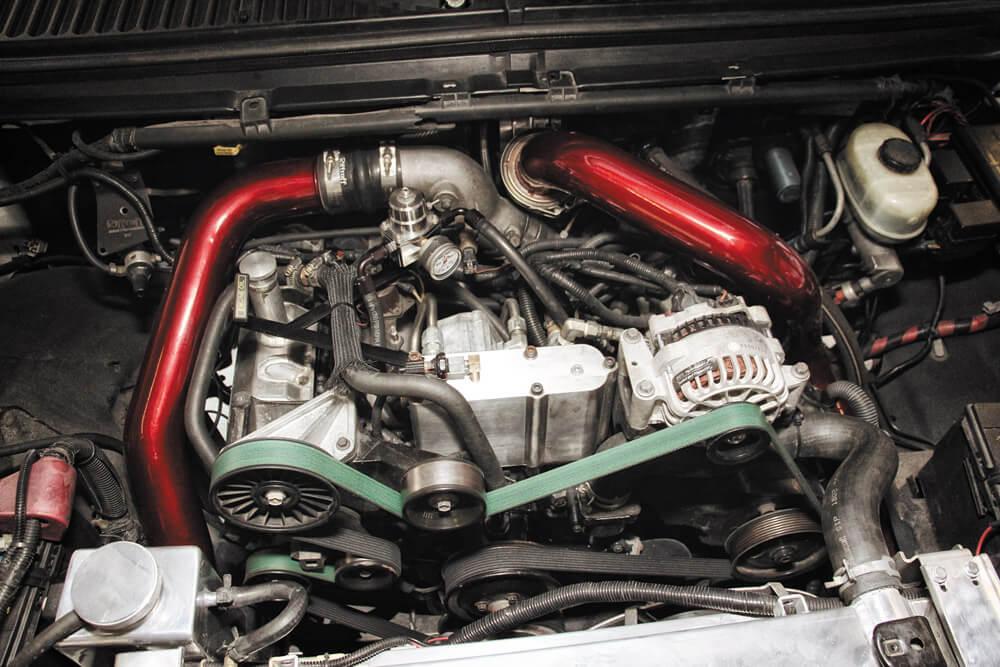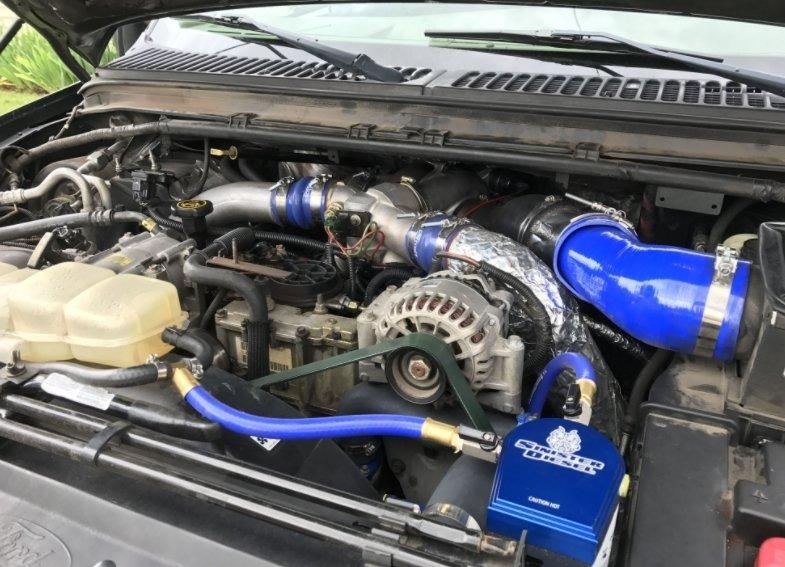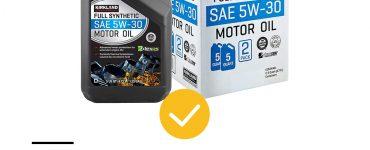The 7.3L Power Stroke diesel engine was offered in Ford trucks from 1994-2003. Though it is no longer in production, the engine remains a popular choice among truck enthusiasts and drivers looking for power and reliability. In this article, we will take a closer look at the 7.3L Power Stroke and explore its features and benefits. We will also compare it to some of the newer diesel engines on the market to see how it stacks up against the competition. So, if you’re considering purchasing a truck with a 7.3L Power Stroke engine, or you just want to learn more about this powerful diesel engine, read on!

Ford 7.3 L Power Stroke Engine Review [hide]
Ford 7.3 L Power Stroke Engine Specs

The Ford 7.3 L Power Stroke engine was introduced in 1994 under the tagline “Direct injection, the technology that’s changing diesel forever.” It replaced the 6.9L IDI (Indirect Injection) V8 Turbo Diesel engine used in Ford Trucks and SUVs from 1986 to 1993. The change to a Direct Injection engine allowed Ford to increase the displacement of their Powerstroke engines, while maintaining more power and fuel efficiency than previous generations.
- Displacement: 444 ci or 7,630 cc
- Bore x Stroke: 4.11″ x 4.49″ 87mm x 114 mm
- Block Material: Cast Iron with 6-bolt main caps
- Compression Ratio: 17.5:1
- Aspiration: Single Turbocharged
- Injection System: Direct Injection (High Pressure Unit Injector)
- Supercharger(s): NA 2400-2800 rpm @ 80 kPa
- Fuel Requirements: Diesel or Biodiesel
- Transfer Case(s): ? – Not factory available
- Engine Control Module: PCM
- Glow Plug Heater: 12 volt
- Turbocharger Boost Pressure: 30-45 psi
- Power Stroke Horsepower: 190-245 hp (depending on year)
- Torque: 400-500 lb-ft (depending on year)
7.3 L Power Stroke Engine Overview
The Ford 7.3 L Power Stroke engine is a diesel engine that was produced by the Ford Motor Company from 1994 to 2003. It was designed as a replacement for the 7.5 L gasoline-powered V8 engine in the Ford F-250 and F-350 trucks. The 7.3 L Power Stroke is a V8 and is the largest diesel engine offered in a production pickup truck by any automotive manufacturer. All versions of the 7.3 use electronically controlled “smart” common rail fuel injection, turbocharging, intercooling and aftercooling with an air to air system.
It is the first diesel engine powered by common rail technology. Common-rail technology was originally developed in Europe, where it has been used for decades. From its European origins, common rail engines have recently become more popular in North America due to their increased power output and reduction in emissions over older indirect injection designs. The 7.3 L Power Stroke uses a Bosch high pressure pump which operates around 20,000 psi (138 MPa) – the highest ever put into an automotive application before or since its production. This common rail system also applied immense amounts of piezoelectric pressure to inject the fuel at a much higher velocity and with increased accuracy compared to any previous diesel injection system. This rail pressure is supplied by a massive high-capacity water cooled condensor attached to the engine’s exhaust manifold, which also serves as the mounting location for the two high-output turbochargers that provide up to 45 psi (310 kPa) or 102 SCFM of boost supply air. The 7.3 L Power Stroke’s electronic engine management system is heavily influenced by modern aircraft engines such as those by Rolls Royce and General Electric, using an advanced 32 bit microprocessor manufactured in the U.S.
7.3 L Power Stroke Engine reliability
The Ford 7.3 L Power Stroke engine is a reliable engine that has been used in a variety of applications. It is known for its durability and power, making it the perfect choice for heavy-duty use. Some of the features that make the 7.3 L Power Stroke engine so popular include:
- Powerful performance – The 7.3 L Power Stroke engine delivers impressive power and torque, making it perfect for towing and hauling heavy loads.
- Durable construction – The engine is built to last, withstanding even the most rigorous demands.
- Easy maintenance – The engine is easy to maintain, ensuring long-term reliability.
If you are looking for a powerful, durable engine for your heavy-duty needs, the Ford 7.3 L Power Stroke engine is a great option. With its impressive performance and long-lasting construction, this engine is sure to meet your needs. So, if you’re looking for a reliable power source, the 7.3 L Power Stroke engine is a great choice.
7.3 L Power Stroke Engine Key Features
Ford’s 7.3 L Power Stroke diesel engine is a powerful workhorse found in a variety of their vehicles. The engine was first produced in 1998 and continued production until 2007. Some of the key features of the 7.3 L Power Stroke include:
- A cast iron block and head for durability
- A four valve per cylinder design for increased performance and efficiency
- High pressure common rail fuel system for better fuel economy
- Turbocharging for more power and better performance
The 7.3 L Power Stroke engine was known for its high torque and towing capacity, making it a popular choice for those who need a reliable workhorse. It is also known for its longevity, with many engines still running strong after more than a decade of use. While the engine is no longer in production, it is still a popular choice for those looking for a powerful diesel engine. Thanks to its durable construction and high performance, the 7.3 L Power Stroke is sure to provide many years of reliable service.
7.3 L Power Stroke Engine Horsepower
Ford claims the 7.3L Power Stroke produces 275hp at 3000 RPM and 610 ft-lbs of torque at 1200 RPM with a 12.5:1 compression ratio, without using any turbocharging or aftermarket modifications. The 7.3L Power Stroke is a favorite amongst Ford Diesel enthusiasts, as it remains the most powerful diesel engine ever produced by Ford for their Trucks and SUVs without requiring modifications or aftermarket components.
7.3 L Power Stroke Engine Oil Viscosity
The viscosity of the oil should be chosen to provide the best protection for the specific operating conditions and environment in which the engine will be used. The 7.3 L Power Stroke Engine is a diesel engine manufactured by Navistar International, and used in medium-duty trucks and busses as well as marine applications such as boats and marine busses. The engine was produced from 1994 to 2010 before it was replaced by the 6.7 L Power Stroke V8 engine. Ford recommends using 5W-20.
Drivers recommend 15-W40 oil for truck diesel engines. It delivers excellent protection for both cold starts and high temperature operations.
7.3 L Power Stroke Engine Oil Capacity
The 7.3 L Power Stroke engine oil capacity is 15 quarts. Use recommended weight oil and the oil filter. The recommended oil change interval is 5,000 miles or 6 months, whichever comes first. It’s important to use the correct type of oil and follow the recommended service intervals to keep your engine running smoothly.
Best Oil for 7.3 L Power Stroke Engine

The best oil for the 7.3 L Power Stroke engine is a diesel engine oil that has been specifically designed for high-output, turbocharged engines. It should meet or exceed the American Petroleum Institute (API) Service CJ-4 specification. The oil should also have a weight of 15W-40 and be certified to the International Engine Oil Standardization and Certification Forum (IOSF) TC-W3 standard. This type of oil will help protect the engine against sludge build-up and wear, while providing optimum performance and fuel economy.
When it comes to picking a brand, nearly any brand of oil will do as long as it’s the correct weight; however, Ford does prefer that its customers use the Motorcraft brand of oil. But car owners often use other trusted brands.
If you are looking for an oil that meets all of these requirements, we recommend Shell Rotella Heavy Duty Diesel Oil. This oil is available at most automotive stores and has been specifically designed for high-output, turbocharged diesel engines. It meets or exceeds the API Service CJ-4 specification and is certified to the IOSF TC-W3 standard.
Customers often choose other trusted brands. These choices also have positive revies:
Ford models using 7.3 L Power Stroke Engine

If you’re looking for a powerful engine that is known for its reliability, the Ford 7.3 L Power Stroke engine may be a good option for you. This engine is used in a variety of Ford models, including the F-250, F-350, and E-350. It offers exceptional performance and fuel economy, making it a popular choice for drivers who need a vehicle that can handle heavy loads or long distances.
The 7.3L was used in the following Ford trucks:
- 1994-1997 Ford F-350
- 1994-1997 Ford F-250
- 1999-2003 Ford F-350
- 1999-2003 Ford F-250
- 2004-2007 Ford Excursion
- 2008-2010 Ford Super Duty
Ford 7.3 L Power Stroke Engine life expancy

Robust, iron parts, conservative power and low engine speed are the key ingredients for any diesel engine lasting forever—and if a 7.3L has gone unmodified yet been well maintained its entire life, 400,000 to 500,000 miles is virtually guaranteed. However, if you modify your engine with things like bigger turbos, more aggressive tunes or aftermarket injectors, that life expectancy goes down. Many Power Stroke owners have reported seeing the typical failure around the 250,000-mile mark when those modifications are made. It’s always a gamble modifying any diesel engine, and the 7.3L is no exception.
Common Issues with 7.3 L Power Stroke Engine
As reliable as the 7.3L may be, it’s not immune to problems. The most common issues include failed fuel injectors (usually caused by running biodiesel), leaky head gaskets (often due to overheating) and blown turbochargers (usually a result of too much boost). All of these problems can often be avoided by keeping your truck well maintained and following the scheduled factory maintenance.
- Power Stroke Engines Seized
It is no secret that the major problem on the 7.3 L Power Stroke is head gasket failure which results in coolant entering into the cylinders causing them to seize up while driving, often with catastrophic results.
In order to prevent this, the head bolts must be torqued down properly in a specific pattern. If they are not done so, it can cause the gasket to fail.
- Turbocharger Failures
Another issue that is common on the 7.3 L Power Stroke is turbocharger failure. This may occur because of dirty or contaminated oil which can damage the turbocharger over time. It may also occur due to the lack of lubrication in the turbocharger or ignition problems that can cause pre-ignition resulting in turbo failure.
- Transmission Issues
The 7.3 liter Power Stroke has had numerous transmission issues; some are unique to certain years while others seem random and do not follow any discernible pattern. One issue common among many Power Stroke owners is a grinding noise that occurs when the truck is put into gear. This problem can be fixed, but it is often expensive.
- Fuel Injection Problems
The fuel injection system on the 7.3 L Power Stroke can also be troublesome. Many times the injectors will become clogged and need to be cleaned or replaced altogether.
This can cause a number of problems for your engine and can even lead to a complete replacement. Sometimes, if the injectors become clogged, the fuel will back up into the cylinders and cause them to seize. Then, in turn, it wreaks havoc on the transmission because all of the oil is released when this happens.
- Head Gasket Failure Due To Low Oil Level
A common problem among many diesel engines is head gasket failure due to low oil levels or using substandard oils that are not approved by manufacturers of these engines. This causes overheating of the engine due to the lack of lubrication and can result in complete failure of the engine.
To prevent this, you should always ensure that the oil level is at the proper level before starting your vehicle. To do so, simply wait until hot idle (approximately 15 minutes), open the hood and remove the dipstick with a clean rag to keep dirt off of it. Be sure to wipe all oil from it first as well as rotating it slightly if there is any question as to whether or not a good amount of oil has been present previously.
If you do experience any issues with your 7.3L, be sure to have it diagnosed and repaired by a qualified mechanic. Trying to fix these problems yourself can often lead to even more expensive repairs down the road. Trustworthy mechanics who are familiar with the 7.3L engine will be able to quickly identify and correct any problems, so you can get back on the road without worry.
Ford 7.3 L Power Stroke Engine Location

The Ford 7.3 L Power Stroke engine is located in the rear of the vehicle, just above the axle. The engine is easily accessible for maintenance and repairs. The engine is also well-protected from road debris and other hazards.
Replacing Ford 7.3 L Power Stroke Engine
If you have a Ford 7.3 L Power Stroke engine, then you’re most likely aware that it is a great truck engine. However, if your engine was not designed with simplicity in mind and you don’t have the time or money to service it yourself, consider getting a re-manufactured powerstroke diesel engine .
When it comes time to replace your Ford 7.3L Power Stroke engine, there are a few simple steps you can take to make the process go as smoothly as possible. The first step is to remove the cowling and battery. This will give you access to the engine mounts and other components that need to be disconnected before the engine can be removed.
Once all of the necessary components have been disconnected, you can begin removing the engine from the truck. Be careful not to damage any of the surrounding components or cables. Once the engine has been removed from its compartment, you can begin the re-installation process.
Replacing the Ford 7.3L Power Stroke engine is not a difficult process, but it is important to take your time and make sure all of the necessary steps are followed correctly. If you’re not comfortable performing this task on your own, we suggest taking your truck to a reputable mechanic for replacement or servicing.


